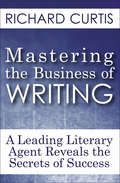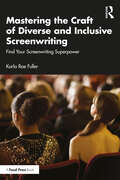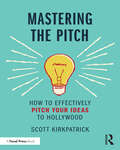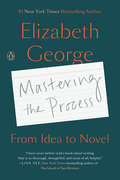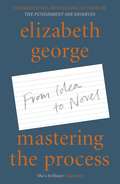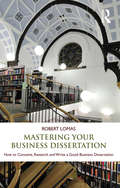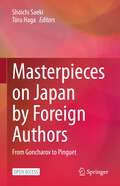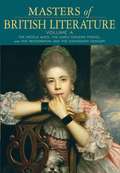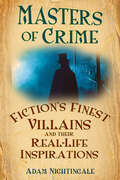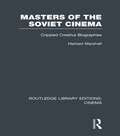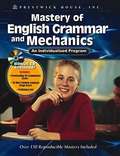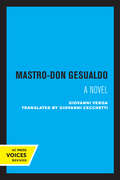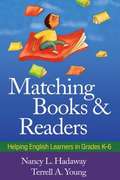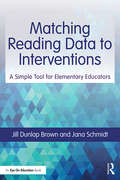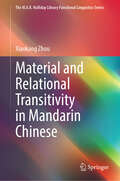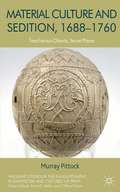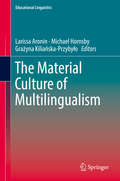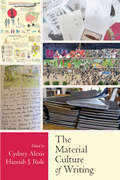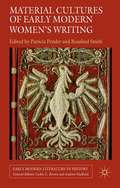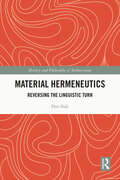- Table View
- List View
Mastering the Business of Writing: A Leading Literary Agent Reveals the Secrets of Success
by Richard CurtisOne of the most comprehensive guides currently on the market, MASTERING THE BUSINESS OF WRITING is an insider's guide to the business of being a professional writer. All aspects of the publishing industry are explained, both for the aspiring author and the established writer wishing to jump start a professional career. This guide includes everything you need to know about publishers, agents, and the track to success, including: What agents do and how they develop relationships within the publishing industry that can be beneficial to your career; the best way to formulate a book proposal that sells; what publishers are really looking for in a book—and what they aren't; understanding technicalities of advances, contracts, multibook deals and subsidiary rights; the significance of sales conferences and bookstore chains; essential manners and protocols for establishing positive relations with your agent, editor and publisher, legal issues, copyright, and much, much more....
Mastering the Craft of Diverse and Inclusive Screenwriting: Find Your Screenwriting Superpower
by Karla Rae FullerThis accessible and informative textbook provides a guide to the craft of screenwriting with an emphasis on diverse perspectives, underrepresented groups and their screen stories. Readers will learn to master writing a feature-length screenplay in a framework that focuses on diversity, equity and inclusion. With case studies to aid understanding, the book explores the screenwriting process in stages, explaining how to create a logline, as well as character bios, writing and choosing a genre, differentiating between writing a treatment, a synopsis, composing an outline, incorporating the formatting process and finally creating a scene and sequence. The techniques specific to screenwriting will also be covered in the text such as writing dialogue and action, establishing setting and time period and most importantly mastering the craft of visual storytelling. At the same time, the textbook introduces concepts of content choices that are diverse and inclusive, such as stereotypes vs. archetypes, intersectional characters, underrepresented groups and themes such as social justice, systemic racism, class conflict, gender inequity and climate change.Due to its subject matter and inclusive approach, this textbook will be an essential guide for all aspiring and current screenwriters who want to successfully navigate and complement today’s developing industry.
Mastering the Craft of Writing: How to Write With Clarity, Emphasis, and Style
by Stephen WilbersMake Every Word Memorable! To be remembered for your words, you need to write with skill and style. Whether you're crafting a novel, composing an e-mail, or creating a technical report, Mastering the Craft of Writing presents 52 practical techniques to improve your prose. Spend a week with each technique, or use this book as a go-to reference. Either way, you'll have the tools to enliven your writing and delight your readers. Write with economy: Eliminate wordiness, use strong verbs to drive your sentences, and don't trust modifiers. Write with emphasis: Use punctuation for effect, structure sentences and paragraphs for coherency and flow, and employ repetition to make your point. Write with distinction: Use your imagination to create the unexpected, add a light-hearted touch to your writing, and go beyond clarity to eloquence and grace. With exercises, entertaining asides, and a wealth of useful information, Mastering the Craft of Writing is an invaluable resource for any writer. Once you master these techniques, you'll want to use them in everything you write.
Mastering the Pitch: How to Effectively Pitch Your Ideas to Hollywood
by Scott KirkpatrickTold from the perspective of a Hollywood executive with nearly 20 years’ experience professionally pitching and distributing film/TV projects, Mastering the Pitch reveals all the nuanced details of the pitching process. Readers will gain valuable insights into how the Hollywood system operates, improve their professional pitching skills and gain a competitive edge in getting their ideas from concept to greenlight. This book covers: how projects are packaged and developed before a pitch; how a pitch presentation happens in a real-world setting; the core concepts required to pitch each genre type; how professional companies actually acquire a pitched project; the legal workflows and financial details required to put a deal together; examples of pitch documents, presentation materials and how these elements should be designed; how to build your personal brand so that you’re seen by Hollywood decision makers as someone capable of delivering great projects; and how you should speak to professionals about the business viability of your projects Mastering the Pitch is a valuable crossover text, designed to help both students and veteran film/TV producers alike hone their pitching and presentation skills.
Mastering the Process: From Idea to Novel
by Elizabeth GeorgeAs the author of twenty-four novels, Elizabeth George is one of the most successful--and prolific--novelists today. In Mastering the Process, George offers readers a master class in the art and science of crafting a novel. This is a subject she knows well, having taught creative writing both nationally and internationally for over thirty years."I have never before read a book about writing that is so thorough, thoughtful, and most of all, helpful." --Lisa See, New York Times bestselling author of The Island of Sea WomenFor many writers, the biggest challenge is figuring out how to take that earliest glimmer of inspiration and shape it into a full-length novel. How do you even begin to transform a single idea into a complete book? In these pages, award-winning, number one New York Times bestselling author Elizabeth George takes us behind the scenes through each step of her writing process, revealing exactly what it takes to craft a novel.Drawing from her personal photos, early notes, character analyses, and rough drafts, George shows us every stage of how she wrote her novel Careless in Red, from researching location to imagining plot to creating characters to the actual writing and revision processes themselves. George offers us an intimate look at the procedures she follows, while also providing invaluable advice for writers about what has worked for her--and what hasn't. Mastering the Process gives writers practical, prescriptive, and achievable tools for creating a novel, editing a novel, and problem solving when in the midst of a novel, from a master storyteller writing at the top of her game.
Mastering the Process: From Idea to Novel
by Elizabeth George'After a number of years teaching writing courses and appearing at writers' conferences, I began to see that creating a process book utilising one of my novels as an example of each step of my process might prove useful to people who are interested in novel writing or in how this individual writer approaches the complicated task of putting together a British crime novel.'As the author of twenty-four novels, Elizabeth George is one of the most successful - and prolific - novelists today. In Mastering the Process, George offers a master class in the art and science of crafting a novel, sharing her wealth of experience with would-be novelists, and with crime fiction fans. Using her actual work to illustrate the various steps of novel writing that she explores in this book, she illustrates her points about plotting, characterisation and technique with great clarity and generosity.Drawing from her personal photos, early notes, character analyses, and rough drafts for every stage of her novel Careless in Red, George offers us an intimate look at the procedures she follows, from researching location to imagining plot to creating characters to the actual writing and revision processes themselves. At the same time, she gives invaluable advice for writers about what has worked for her - and what hasn't. Mastering the Process provides writers with practical, prescriptive, and achievable tools for creating a novel, editing a novel, and problem solving when in the midst of a novel, from a master storyteller at the top of her game.Elizabeth George has taught creative writing both nationally and internationally for over thirty years and is the author of Write Away, described as 'one novelist's approach to fiction and the writing life'.
Mastering the Process: From Idea to Novel
by Elizabeth George'After a number of years teaching writing courses and appearing at writers' conferences, I began to see that creating a process book utilising one of my novels as an example of each step of my process might prove useful to people who are interested in novel writing or in how this individual writer approaches the complicated task of putting together a British crime novel.'As the author of twenty-four novels, Elizabeth George is one of the most successful - and prolific - novelists today. In Mastering the Process, George offers a master class in the art and science of crafting a novel, sharing her wealth of experience with would-be novelists, and with crime fiction fans. Using her actual work to illustrate the various steps of novel writing that she explores in this book, she illustrates her points about plotting, characterisation and technique with great clarity and generosity.Drawing from her personal photos, early notes, character analyses, and rough drafts for every stage of her novel Careless in Red, George offers us an intimate look at the procedures she follows, from researching location to imagining plot to creating characters to the actual writing and revision processes themselves. At the same time, she gives invaluable advice for writers about what has worked for her - and what hasn't. Mastering the Process provides writers with practical, prescriptive, and achievable tools for creating a novel, editing a novel, and problem solving when in the midst of a novel, from a master storyteller at the top of her game.Elizabeth George has taught creative writing both nationally and internationally for over thirty years and is the author of Write Away, described as 'one novelist's approach to fiction and the writing life'.(P) 2020 Penguin Random House Audio
Mastering Your Business Dissertation: How to Conceive, Research and Write a Good Business Dissertation (Routledge Companions In Business, Management And Accounting Ser.)
by Robert LomasThe ability to write to a high standard is a key skill that is often overlooked in the business world. This short book from an international, best-selling author offers a practical guide to conceiving, researching and writing a business or management dissertation. Robert Lomas offers an inspirational treatise that will awaken the quest for knowledge among his readership. The book helps business students to frame their research questions in a more helpful manner in order to achieve their research aims and write in a clear and top scoring way. Topics covered include collecting and measuring data, using business statistics, planning research projects and the real mechanics of writing a dissertation. Masters students across business and management will benefit enormously from reading this book, not just in adding serious value to their dissertations, but also helping to improve their writing skills throughout their business careers. This book includes a foreword by Mark Booth.
Masterpieces on Japan by Foreign Authors: From Goncharov to Pinguet
by Shōichi Saeki Tōru HagaThis open access book includes forty-one chapters about foreign observers’ discourses on Japan. These include a wide range of perspectives from the travelogues of curious visitors to academic theses by scholars, which offer us a broad spectrum of contents, reflecting a variety of attitudes toward Japan. The works were written during the period from the 1850s to the 1980s, a timespan during which Japan became, in stages, more open to the outside world after a long isolation under the Tokugawa shogunate. From the perspective of “Japanology,” one can discern three distinct periods of rising interest in the country from abroad. The first tide of such interest came shortly after the opening of Japan, when various foreign travelers, including those who could not be included in this book, came over and wrote down their impressions of the country—which was, for them, a land of mystery and mystique, which had just opened its doors to them. The second wave arose at the beginning of the twentieth century, just after the Russo-Japanese War, when Japan again generated a remarkable surge of interest as a “miracle” in Asia that had pulled off the wondrous feat of defeating a white superpower. The third wave was more recent, which took place from the late 1960s to the 1980s, a period of high economic growth when the “miracle” of Japan’s remarkable economic recovery from the defeat of World War II attracted enthusiastic and curious attention from the outside world once again. It is not the intention of this book to directly highlight such historical transitions, but these forty-two brilliant mirrors (forty-one chapters, including forty-two discourses), even when looked in casually, provide us with unexpected insights and various perspectives. Shōichi Saeki (1922–2016) was Professor Emeritus, the University of Tokyo. Tōru Haga (1931–2020) was Professor Emeritus, International Research Center for Japanese Studies.
Masters of British Literature, Volume A
by David Damrosch Jennifer Wicke Susan J. Wolfson Christopher Baswell Kevin J. H. Dettmar Clare Carroll Heather Henderson Constance Jordan Peter J. Manning Anne Howland Schotter William Chapman Sharpe Stuart ShermanWritten by an editorial team whose members are all actively engaged in teaching and in current scholarship, Masters of British Literature is a concise, yet comprehensive survey of the key writers whose classic works have shaped British literature. Featuring major works by the most influential authors in the British literary tradition-Chaucer, Spenser, Shakespeare, Sidney, Donne, Milton, Behn, Swift, Pope, Johnson-this compact anthology offers comprehensive coverage of the enduring works of the British literary tradition from the Middle Ages through the Restoration and the eighteenth century. Core texts are complemented by contextual materials that help students understand the literary, historical, and cultural environments out which these texts arose, and within which they find their richest meaning.
Masters of British Literature, Volume B
by David Damrosch Susan J. Wolfson Christopher Baswell Clare Carroll Kevin J. H. Dettmar Heather Henderson Constance Jordan Peter J. Manning Stuart Sherman Jennifer WickeWritten by an editorial team whose members are all actively engaged in teaching and in current scholarship, Masters of British Literature is a concise, yet comprehensive survey of the key writers whose classic works have shaped British literature. Featuring major works by the most influential authors in the British literary tradition--Barbauld, Blake, Wollstonecraft, Wordsworth, Coleridge, Keats, Barrett Browning, Browning, Tennyson, Yeats, Woolf, Joyce, Eliot, Walcott, Heaney, and Rushdie--this compact anthology combines comprehensive coverage of the enduring works of the British literary tradition from the Romantics through the twentieth century. Core texts are complemented by contextual materials that help students understand the literary, historical, and cultural environments out which these texts arose, and within which they find their richest meaning.
Masters of Crime: Fiction's Finest Villains and Their Real-Life Inspirations
by Adam NightingaleThis fascinating volume reveals the real men – and women – behind some of the most infamous London villains ever to appear in fiction. Fagin, Professor Moriarty, Moll Cutpurse and the notorious 'cracksman' A.J. Raffles were all rooted in the lives and deaths of a litany of real-life criminals, agitators and activists. With a special emphasis on the city that spawned them, this book brings together their stories for the first time, and shows how they were woven into fiction by some of Britain’s greatest writers, including Charles Dickens and Arthur Conan Doyle. Containing prison escapes, sensational trials, daring art thefts, vicious attacks, roaring boys, black magicians and private detectives, Masters of Crime explores both the real underworld of British crime history, and its fictional counter-parts. It will delight fans of true crime and crime fiction alike.
Masters of the Soviet Cinema: Crippled Creative Biographies (Routledge Library Editions: Cinema)
by Herbert MarshallEisenstein, Pudovkin, Dovzhenko, Vertov: these Soviet film directors are acknowledged to be among the greatest in the history of cinematography. To Eisenstein we owe such films as Battleship Potemkin and October; to Pudovkin Mother and The End of St Petersburg; to Dovzhenko Earth and Zvenigora; and to Vertov The Man With a Movie Camera and The Three Songs of Lenin. Herbert Marshall knew each of them personally, both as artists and as friends, and shared their cinema world when he was a student at the GIK (The Moscow State Institute of Cinematography) in the heady years following the Revolution into the period of the first Five Year Plan. His material is culled from personal recollections, diaries, notes, unpublished and published biographies, letters, press cuttings, articles and books in various languages, but mainly from Soviet sources and the Soviet cinema world. Taking the subjects one by one, this indispensible book discusses their major films including an account of their creation and reception in the USSR and abroad. It shows the tragedy of these four Soviet artists who were lucky enough not to be arrested or deprived of their limited freedom, yet who nevertheless ended up with ‘crippled creative biographies’. The author then examines the changed viewpoint in the climate of 1983 when the book was originally published.
Mastery of English Grammar and Mechanics: An Individualized Program
by Prestwick House IncA language arts textbook. Identify and correct grammar and mechanics problems quickly and efficiently with Mastery of Grammar and Mechanics: An Individualized Program. <P><P>Twelve of the most troubling areas for students, such as showing possession, subject/verb agreement, and using proper punctuation, are clearly explained in brief, targeted lessons with multiple practice exercises and a mastery test for each lesson.
Mastro-Don Gesualdo: A Novel
by Giovanni VergaThis title is part of UC Press's Voices Revived program, which commemorates University of California Press’s mission to seek out and cultivate the brightest minds and give them voice, reach, and impact. Drawing on a backlist dating to 1893, Voices Revived makes high-quality, peer-reviewed scholarship accessible once again using print-on-demand technology. This title was originally published in 1979.
Matching Books and Readers
by Nancy Hadaway Terrell YoungProviding practical guidance and resources, this book helps teachers harness the power of children's literature for developing ELLs' literacy skills and language proficiency. The authors show how carefully selected fiction, nonfiction, and poetry can support students' learning across the curriculum. Criteria and guiding questions are presented for matching books and readers based on text features, literacy and language proficiency, and student background knowledge and interests. Interspersed throughout are essays and poems by well-known children's authors that connect in a personal way with the themes explored in the chapters. The annotated bibliography features over 600 engaging, culturally relevant trade titles.
Matching Reading Data to Interventions: A Simple Tool for Elementary Educators
by Jill Dunlap Brown Jana SchmidtThis accessible and reader-friendly book will help you assess and determine the foundational reading needs of each of your K – 5 students. Literacy leaders Jill Dunlap Brown and Jana Schmidt offer an easy-to-use data analysis tool called, "The Columns" for teachers at all levels of experience to make sense of classroom data for elementary readers. This book will guide you in using the tool to identify the root causes of foundational reading deficits and to plan appropriate interventions. Sample case studies allow you to practice identifying needs and matching interventions. Stories and examples throughout the book will encourage you as you help your students meet their full potential. The book provides easy-to-use and printable versions of the data analysis columns that will enable you to put the authors‘ advice into immediate action. These tools are available for download on the book’s product page: www.routledge.com/9780367225070
Material Ambitions: Self-Help and Victorian Literature
by Rebecca RichardsonWhat the Victorian history of self-help reveals about the myth of individualism.Stories of hardworking characters who lift themselves from rags to riches abound in the Victorian era. From the popularity of such stories, it is clear that the Victorians valorized personal ambition in ways that previous generations had not. In Material Ambitions, Rebecca Richardson explores this phenomenon in light of the under-studied reception history of Samuel Smiles's 1859 publication, Self-Help: With Illustrations of Character, Conduct, and Perseverance. A compilation of vignettes about captains of industry, artists, and inventors who persevered through failure and worked tirelessly to achieve success in their respective fields, Self-Help links individual ambition to the growth of the nation. Contextualizing Smiles's work in a tradition of Renaissance self-fashioning, eighteenth-century advice books, and inspirational biography, Richardson argues that the burgeoning self-help genre of the Victorian era offered a narrative structure that linked individual success with collective success in a one-to-one relationship. Advocating for a broader cultural account of the ambitious hero narrative, Richardson argues that reading these biographies and self-help texts alongside fictional accounts of driven people complicates the morality tale that writers like Smiles took pains to invoke. In chapters featuring the works of Harriet Martineau, Dinah Craik, Thackeray, Trollope, and Miles Franklin, Richardson demonstrates that Victorian fiction dramatized ambition by suggesting where it runs up against the limits of an individual's energy and ability, where it turns into competition, or where it risks upsetting a socio-ecological system of finite resources. The upward mobility plots of John Halifax, Gentleman or Vanity Fair suggest the dangers of zero-sum thinking, particularly evidenced by contemporary preoccupations with Malthusian and Darwinian discourses. Intertwining the methodologies of disability studies and ecocriticism, Material Ambitions persuasively unmasks the longstanding myth that ambitious individualism can overcome disadvantageous systematic and structural conditions.
Material and Relational Transitivity in Mandarin Chinese (The M.A.K. Halliday Library Functional Linguistics Series)
by Xiaokang ZhouThis book presents a systemic-functional analysis of aspects of transitivity in Mandarin Chinese, focusing on two major types of clause: material clauses and relational clauses. Material clauses represent actions/events in the material world. Relational clauses express relationships between entities in the most general sense; they include as their prototypical members ‘being’ or ‘copula’ clauses. It demonstrates a brief account of the theoretical framework of SFG. The book also provides a detailed description of material clauses, to deal in turn with three major types of relational clause: attributive, locational, and possessive. One of the significant findings of the monograph is that relational clauses encompass a much larger portion of the grammar than is usually believed and include various ‘processes’ such as ‘giving’, ‘renting’, ‘putting’, in addition to ‘being’ (usually classified as material). Hence, the notion of transitivity has been refined.
Material and Symbolic Circulation between Spain and England, 1554–1604 (Transculturalisms, 1400-1700)
by Anne J. CruzSeparated only by a narrow body of water, Spain and England have had a long history of material and cultural interactions; but this intertwined history is rarely perceived by scholars of one country with a view toward the other. Through their analyses of the various modes of exchange of material goods and the circulation of symbolic systems of meaning, the contributors to the anthology-historians and literary critics-investigate, for the first time, the two nations' express points of contact and conflict during these historically crucial fifty years. Focusing on the half-century period that began with the marriage of Mary Tudor to Prince Philip of Spain, and spanned the reigns of Philip II and Elizabeth I of England, the essays in this anthology demonstrate and problematize, from the perspective of Spanish cultural history, the significant material, cultural, and symbolic contacts between the two countries. The volume shows how the two countries' alliances and clashes, which led to the debacle of the 'Invincible Armada' of 1588 and continued for decades afterwards, held enormous historical significance by shaping the religious, political, and cultural developments of the modern world.
Material Culture And Sedition, 1688–1760
by Murray PittockMaterial Culture and Sedition, 1688-1760 is a groundbreaking study of the ways in which material culture (and its associated designs, rituals and symbols) was used to avoid prosecution for treason and sedition in the British Isles. The fresh theoretical model it presents challenges existing accounts of the public sphere and consumer culture.
The Material Culture of Multilingualism (Educational Linguistics #36)
by Larissa Aronin Michael Hornsby Grażyna Kiliańska-PrzybyłoThis volume provides a unique interface between the material and linguistic aspects of communication, education and language use, and cuts across traditional disciplinary boundaries, drawing on fields as varied as applied linguistics, ethnology, sociology, history and philosophy. Taking texts, images and objects as their starting points, the authors discuss how cultural context is envisioned in particular materialities and in a variety of contexts and localities. The volume, divided into three sections, aims to deal with material culture not only in the daily language practices of the past and the present, but also language teaching in a number of settings. The main thrust of the volume, then, is the exposure of natural ties between language, cognition, identity and the material world. Aimed at undergraduates, postgraduates and scholars in fields as varied as education, applied linguistics, sociolinguistics, semiotics and other related disciplines, this volume documents and analyses a wide range of case studies. It provides a unique take on multilingualism and expands our understanding of how materialities permit us new and unexpected insights into multilingual practices.
The Material Culture of Writing
by Cydney Alexis Hannah J. RuleThe Material Culture of Writing opens up avenues for understanding writing through scholarship in material culture studies. Contributors to this volume each interrogate an object, set of objects, or writing environment to reveal the sociomaterial contexts from which writing emerges. The artifacts studied are both contemporary and historical, including ink, a Victorian hotel visitors’ book, Moleskine notebooks, museum conservators’ files, an early twentieth-century baby book, and a college campus makerspace. Close study of such artifacts not only enriches understanding of what counts as writing but also offers up the potential for rich current and historical inquiry into writing artifacts and environments. The collection features scholars across the disciplines—such as art, art history, English, museum studies, and writing studies—who work as teachers, historians, museum curators/conservators, and faculty. Each chapter features methods and questions from contributors’ own disciplines while at the same time speaking to writing studies’ interest in writers, writing identity, and writing practice. The authors in this volume also work with a variety of methodologies, including literary analysis, archival research, and qualitative research, providing models for the types of research possible using a material culture studies framework. The collection is organized into three sections—Writing Identity, Writing Work, Writing Genre—each with a contextualizing introduction from the editors that introduces the chapters themselves and imagines possible directions for writing studies research facilitated by material culture studies. The Material Culture of Writing serves as an accessible introduction to work in material culture studies for writing studies scholars, graduate students, and undergraduates, especially as it makes a distinctive contribution to writing studies in its material culture studies approach. Because of the interdisciplinarity of material culture studies and this volume’s contributors, this collection will appeal to a wide range of scholars and readers, including those interested in writing studies, the history of the book, print culture, genre studies, archival methods, and authorship studies. Contributors: Cydney Alexis, Debby Andrews, Diane Ehrenpreis, Keri Epps, Desirée Henderson, Kevin James, Jenny Krichevsky, Anne Mackay, Emilie Merrigan, Laura R. Micciche, Hannah J. Rule, Kate Smith
Material Cultures of Early Modern Women’s Writing
by Patricia Pender Rosalind SmithThis collection examines the diverse material cultures through which early modern women's writing was produced, transmitted, and received. It focuses on the ways it was originally packaged and promoted, how it circulated in its contemporary contexts, and how it was read and received in its original publication and in later revisions and redactions.
Material Hermeneutics: Reversing the Linguistic Turn (History and Philosophy of Technoscience)
by Don IhdeMaterial Hermeneutics explores the ways in which new imaging technologies and scientific instruments have changed our notions about ancient history. From the first lunar calendar to the black hole image, and from an ancient mummy in the Italian Alps to the irrigated valleys of Mesopotamia, this book demonstrates how revolutions in science have taught us far more than we imagined. Written by a leading philosopher of technology and utilizing an interdisciplinary approach, this book has implications for many fields, including philosophy, history, science, and technology. It will appeal to scholars and students of the humanities, as well as anthropologists and archaeologists.
